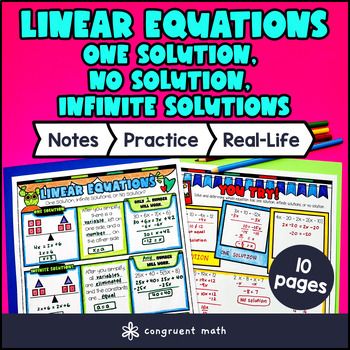Want more ideas and freebies?
Get my free resource library with digital & print activities—plus tips over email.
Join for Free Resources →
$4.25
Ever wondered how to teach linear equations in one variable with one solution, no solution, or infinite solutions in an engaging way to your 8th grade students? In this lesson plan, students will learn about solving linear equations and their real-life applications. Through artistic, interactive guided notes, check for understanding questions, a doodle and color by number activity, and a maze worksheet, students will gain a comprehensive understanding of linear equations with different solutions. The lesson ends with a real-life example that explores how linear equations can be applied in a practical context.

$4.25
After this lesson, students will be able to:
Before this lesson, students should be familiar with:
As a hook, ask students why linear equations are important in real life situations. For example, ask them how they might use linear equations to solve problems related to budgeting or predicting future costs. Refer to the last page of the guided notes, which includes a real-life math application, for ideas.
Use the first page of the guided notes to introduce the concept of linear equations with one solution. Walk through the guided notes, explaining key points such as how to identify linear equations with one solution, no solution, or infinite solutions. This includes modeling with the scale and completing an example for each scenario. Refer to the FAQ below for a walk through on this, as well as ideas on how to respond to common student questions.
Based on student responses, reteach concepts that students need extra help with. If your class has a wide range of proficiency levels, you can pull out students for reteaching, and have more advanced students begin work on the practice exercises.
Have students practice solving linear equations with one solution, infinite solutions, and no solutions using the practice worksheet (pg. 2) included in the resource. They can complete the maze (pg. 3) and color by code (pg. 4) to reinforce the concepts learned in the guided notes.
Walk around the classroom to answer any questions students may have and provide support as needed.
For fast finishers, they can continue practicing with the real-life application activity included in the resource. This activity allows students to read and write about real-life uses of solving linear equations with different solutions.
Use the last page of the guided notes to bring the class back together, and introduce the concept of real-world applications of linear equations with one solution, infinite solutions, or no solution. Explain that linear equations can be used to model real-life situations and solve problems.
Additional examples of real-life applications include:
Refer to the FAQ for more ideas on how to teach real-life applications of linear equations.
If you’re looking for digital practice for linear equations with one solution, infinite solutions, or no solution, try my Pixel Art activities in Google Sheets. Every answer is automatically checked, and correct answers unlock parts of a mystery picture. It’s incredibly fun, and a powerful tool for differentiation.
Here are some activities to explore:
Linear equations are mathematical equations that involve variables and are described by a straight line on a graph. They are used to represent relationships between different quantities.
To solve a linear equation with one solution, you need to isolate the variable on one side of the equation.
A linear equation has no solution if the equation simplifies to a statement that is always false, such as 2 = 5.
A linear equation has infinitely many solutions if the equation simplifies to a statement that is always true, such as 3 = 3.
Examples of linear equations with one solution could be:
Examples of linear equations with no solution could be:
Examples of linear equations with infinitely many solutions could be:
Linear equations are used in various real-life applications, such as:
To make learning about linear equations more engaging, you can:
Get my free resource library with digital & print activities—plus tips over email.
Join for Free Resources →